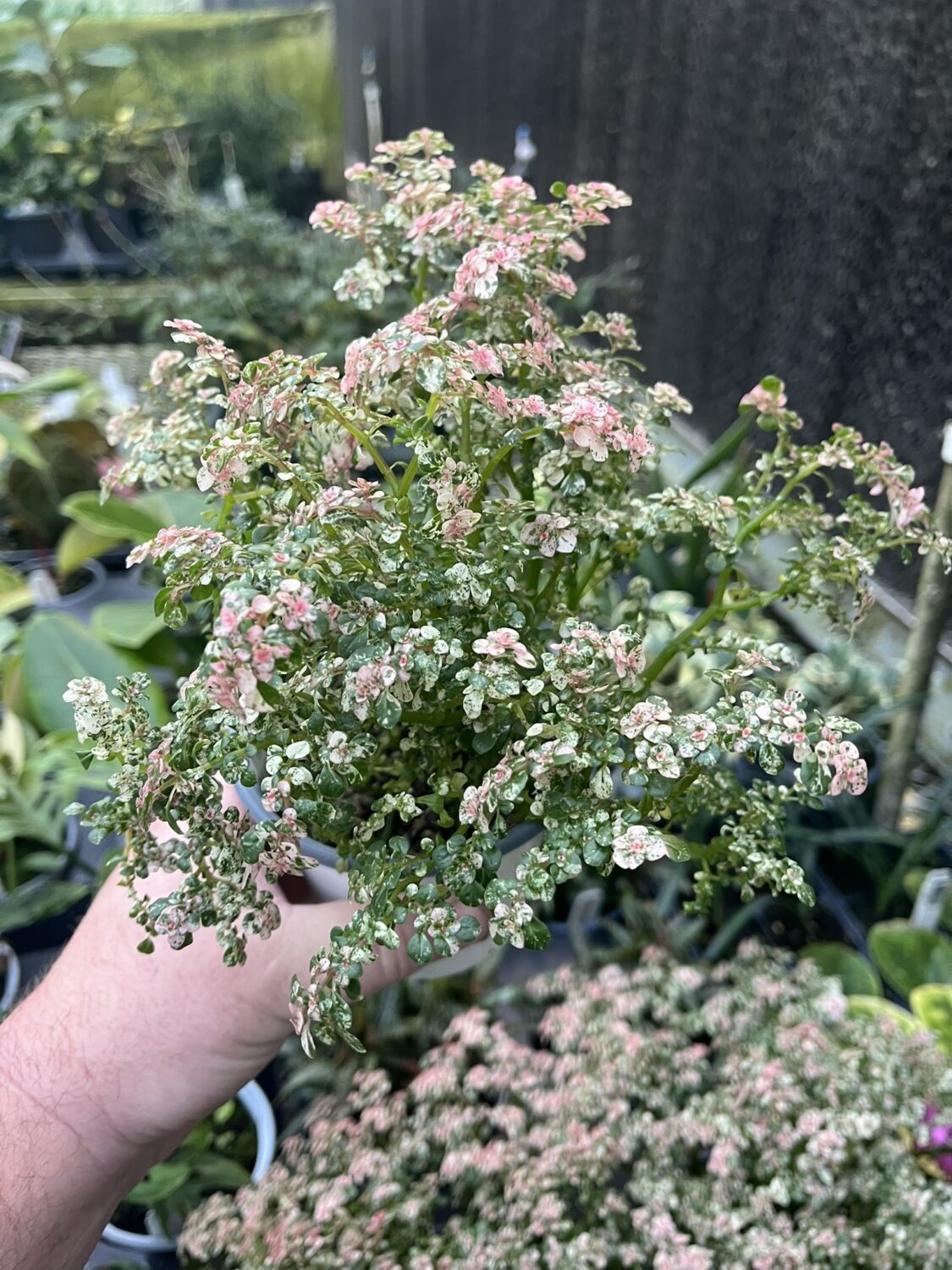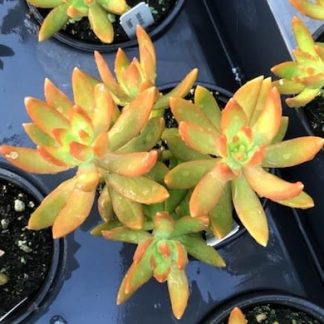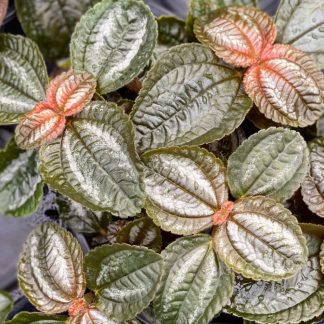Description
Pilea microphylla variegata: The Variegated Artillery Fern
Pilea microphylla variegata, often called the Variegated Artillery Fern, is one of those plants that quietly transforms any space. It’s not actually a fern at all but a member of the Urticaceae family. Its tiny, fleshy leaves and creamy-white variegation give it a soft, almost airy look. Native to tropical and subtropical regions, this plant has earned its reputation for being charming, versatile, and—best of all—easy to care for.
Whether you want a delicate accent for a shelf indoors or a lush groundcover outdoors, Pilea microphylla variegata fits the bill. Its trailing habit looks lovely cascading from containers, and it thrives equally well in hanging baskets or as a filler in mixed arrangements. Let’s explore everything you need to know to grow this resilient and beautiful plant successfully.
Why Grow Variegated Artillery Fern?
Before diving into care details, it helps to understand why this plant is so beloved:
-
Compact and adaptable: It thrives in containers, garden beds, or terrariums.
-
Delicate foliage: Tiny, variegated leaves create a soft, cloud-like texture.
-
Fast-growing: It fills out spaces quickly without becoming invasive.
-
Low maintenance: Perfect for beginners and experienced gardeners alike.
-
Airy accent: Adds lightness to heavy arrangements or dense plantings.
Its mix of elegance and ease makes it a go-to choice for indoor jungles and outdoor patios alike.
Planting and Propagation
Variegated Artillery Fern is quick to multiply. Propagation is one of the easiest—and most rewarding—parts of growing it.
Propagation Methods
You can propagate it in three ways:
-
Stem cuttings (most common and fastest)
-
Division of clumps
-
Seeds (less common, slower method)
How to Propagate with Stem Cuttings
-
Use clean, sterilized scissors to snip a 2–4 inch stem from a healthy plant.
-
Remove the lower leaves to expose the nodes.
-
Place the cutting either in water or directly into moist, well-draining soil.
-
If rooting in water, wait 1–2 weeks for roots to reach about an inch long before transplanting to soil.
-
Keep the new plant in bright, indirect light and lightly moist soil until it establishes.
This method is perfect for creating new plants to share with friends or fill multiple pots in your own garden.
Light Requirements
Light plays a big role in maintaining the variegation of this plant.
-
Indoors: Place near an east- or north-facing window where sunlight is bright but filtered.
-
Outdoors: Choose partial shade to shield leaves from intense midday sun.
Too much direct sunlight can scorch the delicate foliage. On the other hand, too little light may cause the creamy variegation to fade. Rotate your plant occasionally for even growth.
Soil Preferences
The right soil mix makes a big difference in keeping this plant healthy.
Ideal Soil Mix:
-
2 parts standard potting soil
-
1 part perlite or coarse sand
-
1 part peat moss or coconut coir
This combination holds moisture while ensuring good drainage—important for preventing root rot.
Watering Needs
Pilea microphylla variegata prefers consistent moisture but not soggy soil.
-
Check soil moisture: Water when the top inch feels dry.
-
Reduce in winter: Growth slows during cooler months, so water less frequently.
-
Avoid standing water: Always empty saucers to prevent root problems.
Watch the leaves for clues: drooping often signals underwatering, while yellowing can mean overwatering.
Temperature and Humidity
Being tropical, this plant loves warmth and humidity but adapts well indoors.
-
Temperature range: 65–80°F (18–27°C)
-
Humidity preference: Average household humidity is fine, but it thrives with extra moisture.
Boost humidity with misting, grouping plants together, or using a pebble tray with water. Keep it away from cold drafts, heaters, or air conditioning vents.
Feeding and Fertilization
A light feeding schedule keeps the foliage lush and vibrant.
-
Use a balanced, water-soluble fertilizer at half strength.
-
Feed every 4–6 weeks during spring and summer.
-
Pause feeding in fall and winter when growth naturally slows.
Flush the soil occasionally with plain water to prevent fertilizer buildup.
Pruning and General Care
Pruning is simple and helps maintain shape while encouraging bushier growth.
-
Trim back leggy or overgrown stems using clean scissors.
-
Remove yellowing or damaged leaves to keep it looking fresh.
-
Pinch back stem tips to promote a fuller, denser plant.
Bonus tip: Use trimmed stems for propagation, so nothing goes to waste.
Common Pests and Problems
This plant is generally pest-resistant but can occasionally attract:
-
Spider mites (look for fine webbing)
-
Mealybugs (cotton-like spots on stems)
-
Aphids (sticky residue or distorted leaves)
How to Manage Pests
-
Wipe leaves with a damp cloth or rinse the plant under lukewarm water.
-
Spray with mild soapy water or neem oil for persistent infestations.
Preventing Disease
-
Avoid overwatering to prevent root rot.
-
Ensure good airflow to reduce mildew or mold issues.
Repotting
Repot every 1–2 years or sooner if the plant outgrows its container.
Signs It’s Time to Repot
-
Roots circling the bottom of the pot
-
Soil dries out faster than usual
-
Plant looks crowded or growth slows
Repotting Steps
-
Gently remove the plant from its pot.
-
Shake off old soil and trim any damaged roots.
-
Place in a slightly larger pot with fresh soil.
-
Water lightly and let it settle in a shaded spot for a few days.
Seasonal Care and Special Tips
-
Rotate regularly for even light exposure.
-
Wipe leaves occasionally to remove dust and boost photosynthesis.
-
Bring outdoor plants inside before temperatures drop below 55°F (13°C).
Because it’s not frost-tolerant, treat it as a tender perennial or annual outdoors in colder zones.
Where This Plant Shines
The Variegated Artillery Fern is incredibly versatile:
-
Indoor décor: Perfect for bookshelves, windowsills, or mixed plant displays.
-
Groundcover: Creates a lush carpet in shady garden beds.
-
Terrariums: Its small size and soft texture complement enclosed plantings.
-
Hanging baskets: Lovely trailing habit for patios or balconies.
Pair it with bold foliage plants to contrast its fine texture, or use it to soften hard edges in garden borders.
Why Gardeners Love It
What makes this plant so appealing is how easily it adapts to different lifestyles. It looks delicate but is surprisingly resilient. It’s forgiving of occasional neglect yet rewards consistent care with quick growth and vibrant color. Plus, its compact size makes it perfect for small apartments, offices, and balconies.
Bringing Home the Gentle Beauty
Pilea microphylla variegata is proof that small plants can make a big impact. With its soft variegation, fern-like texture, and versatile growth habit, it fits seamlessly into almost any garden style or indoor setting. Whether you’re just starting your plant journey or adding to a seasoned collection, this plant offers beauty without fuss.
If you’re looking for something elegant yet easy to care for—something that brightens up corners and softens arrangements—the Variegated Artillery Fern might just be your next favorite plant.




